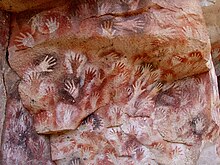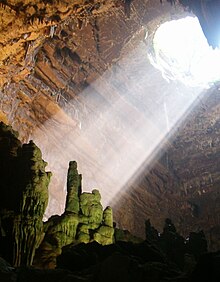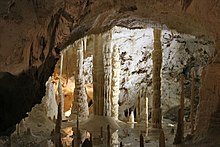Cave
These may involve a combination of chemical processes, erosion by water, tectonic forces, microorganisms, pressure, and atmospheric influences.[4] It is estimated that a cave cannot be more than 3,000 metres (9,800 ft) vertically beneath the surface due to the pressure of overlying rocks.Other caves formed through volcanic activity include rifts, lava molds, open vertical conduits, inflationary, blisters, among others.A special case is littoral caves, which are formed by wave action in zones of weakness in sea cliffs.Elsewhere, in places such as Thailand's Phang Nga Bay, solutional caves have been flooded by the sea and are now subject to littoral erosion.Corrasional or erosional caves are those that form entirely by erosion by flowing streams carrying rocks and other sediments.[9] Many caves formed initially by solutional processes often undergo a subsequent phase of erosional or vadose enlargement where active streams or rivers pass through them.As the world's expanses of soluble bedrock are researched by cavers, the distribution of documented caves is likely to shift.For example, China, despite containing around half the world's exposed limestone—more than 1,000,000 square kilometres (390,000 sq mi)—has relatively few documented caves.For instance, in the eastern temperate United States, cave entrances are most frequently (and often densely) populated by the bulblet fern, Cystopteris bulbifera.The cave sites of Sterkfontein, Swartkrans, Kromdraai B, Drimolen, Malapa, Cooper's D, Gladysvale, Gondolin and Makapansgat have yielded a range of early human species dating back to between three and one million years ago, including Australopithecus africanus, Australopithecus sediba and Paranthropus robustus.The first early hominid ever found in Africa, the Taung Child in 1924, was also thought for many years to come from a cave, where it had been deposited after being predated on by an eagle.Archaeologists have uncovered relationships between paintings of dots and lines, in specific areas of resonance, within the caves of Spain and France, as well as instruments depicting paleolithic motifs,[30] indicators of musical events and rituals.[33] During the 20th century musicians began to explore the possibility of using caves as locations as clubs and concert halls, including the likes of Dinah Shore, Roy Acuff, and Benny Goodman.[citation needed] Unlike today, these early performances were typically held in the mouths of the caves, as the lack of technology made depths of the interior inaccessible with musical equipment.[34] In Luray Caverns, Virginia, a functioning organ has been developed that generates sound by mallets striking stalactites, each with a different pitch.










Cave (disambiguation)Cavern (disambiguation)Lechuguilla CaveNew Mexicosurfaceweatheringrock sheltersSpeleologycaving, potholing, or spelunkingspeleogenesislimestonedissolutionSpeleothemsOgof Craig a FfynnonSouth WalesSolutional cavedolomitemarblegypsumsalt cavesgroundwaterbedding planesfaultscarbonic acidorganic acidssinkholescalcium carbonateprecipitationflowstonesstalactitesstalagmiteshelictitessoda strawswater tableCarlsbad Cavernhydrogen sulfidesulfuric acidlava tubeHawaiiLava tubesvolcanicCanary IslandsJeju-doEastern IdahoKazumura CaveSea caveSanta Cruz IslandCaliforniaThailandPhang Nga BayMount SodomGlacier caveBig Four MountainWashingtonvery slow flowice cavesTalus caverockfallslandslidesAnchialine caveCastellana Cavesgroundwater rechargePit cavesDomica CaveSlovak KarstSlovakiaFinlandFrasassi CavesMadagascar dry deciduous forestsBrazilMammoth CaveKentuckySistema Ox Bel HaYucatánVeryovkina CaveAbkhaziaGeorgiaGouffre BergerLamprechtsofen Vogelschacht Weg SchachtVrtoglavica CaveSloveniaKermanshahremotely operated underwater vehicleHranice AbyssCzech RepublicMiao RoomSarawak ChamberGunung Mulu National ParkSarawakBorneoMalaysiashow caveSalle de la VernaPyreneesSon Doong CavePhong Nha-Kẻ Bàng National ParkQuảng Bình ProvinceVietnamList of longest cavesSistema Sac ActunSistema Dos OjosJewel CaveSouth DakotaShuanghedong Cave NetworkBiospeleologyTownsend's big-eared batstroglobitestroglophilestrogloxenesstygobitesstygophilesstygoxenesAlabama cave shrimpcave salamandersTexas blind salamanderCave insectsSt Cuthberts Swalletgray batMexican free-tailed batcave cricketsTooth cave spiderliphistius trapdoor spiderCystopteris bulbiferaCueva de las ManosPerito MorenoArgentina



